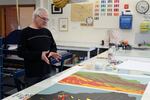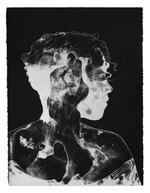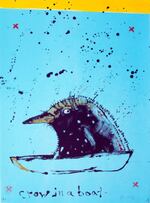
Master printer Frank Janzen finishing up several prints for the artist James Lavadour at the Crow's Shadow Institute of the Arts.
Aaron Scott / OPB
Limited edition prints are a wonderful thing in the art world. They make it so an artist can offer multiples of their work at a more affordable price, meaning more of us get the joy of owning them.
But artists themselves rarely make the prints. They conceive of the work in collaboration with a printer, who then reproduces it.
The world of fine art printers is small and unsung, and Oregon has been blessed with one of the best.
Frank Janzen has worked with nearly 50 artists — national stars and emerging names alike — at the Crow's Shadow Institute of the Arts outside Pendleton. He's hand-pressed a majority of the Institute's more than 200 works, which tour the world.
To celebrate the Institute's 25th anniversary, the Hallie Ford Museum of Art is exhibiting a retrospective that opens in Salem this weekend and runs through Dec. 22. Janzen himself will be part of an opening panel discussion on Sept. 23 at 2:15 p.m. with Crow's Shadow founder James Lavadour, the artists and institute regular Marie Watts, and others.
Janzen is set to retire at the end of the year and is already training his replacement, Judith Baumann. "State of Wonder" producer Aaron Scott headed out to the old missionary school that houses Crow’s Shadow in the rolling hills of the Confederated Tribes of the Umatilla Indian Reservation to see what’s kept Janzen at the presses all these years.
Q&A with Frank Janzen
Aaron Scott: Take me through a residency. Where do you start with an artist on day one?
Frank Janzen: I find out if they have a sense of humor. I find it loosens everything up. Some artist will come, and they've never done a print before in their life. They're nervous. But you try to make them feel comfortable, and we start talking about what they possibly have in mind. The first couple days is chatting: how do you want to make your mark? And I give them the tools to do that.
Samantha Wall was a prime example.
Scott: Samantha Wall, who is a fast-rising star in Portland and does mostly portraits of women.
Janzen: A lot of it is herself. These series are, and they're incredible prints. They look like the inner workings of the body, they look like Outer Space, they look like all sorts of things, and that's what makes them exciting.
Frank Janzen sees himself mostly as a facilitator. He knew Samantha Wall drew with graphite and India ink on paper, so he experimented with crayon and ink on mylar to see if he could get a similar effect.
Janzen: She took one look at it and said, "I could use that." So we printed them black on white paper, and she looked at it and said, "Meh, it looks just like my drawing. There's nothing spectacular about it."

"Dark Matter (Universal Body 1)" by Samantha Wall
Courtesy of Crow's Shadow Institute of the Arts
So her husband, Steven, was staying here as well. The next morning she comes up to me and says, "Can you print silver on black?"
"Yeah."
So what Stephen had done was taken a photograph of it and inverted it in Photoshop. Bang.
So I had to print the paper black — it's not black paper, it's printed black because you have the richness — and then I printed silver on top, and I just went, wow.
The exciting part about this is that the way that our publication costs work, when we finally printed the editions, her and Stephen came out here to sign them, we gave her a check because we had pre-sold seven. So yeah it's pretty cool.
Scott: It’s such an interesting relationship because, on one hand, you’re the master printer who knows how things work. But they’re the artists, which creates an interesting balance between having more knowledge but being in the assisting position.
Janzen: Basically the worst part is to work with people who are printmakers or think they're printmakers, because they "know everything."
Scott: Whereas everyone else comes with curiosity?
Janzen: They're curiosity, they just go with the flow and then they start becoming excited when results start coming through, and it's pretty amazing.
Scott: Who comes to mind as one of the funnest people to work with?
Janzen: The funnest artist was probably Rick Bartow. He's an icon. He only stays for a week, but he basically does what we call a series of mono prints. In other words, he'll do a key image of a bird, which is a lithographic method on a photo plate, and then we do monotypes: We do different backgrounds and he draws back into them.

"Crow in a Boat" by Rick Bartow
Courtesy of Crow's Shadow Institute of the Arts
The last time, especially, in 2013, we did 75 mono prints — four different series — in four and a half days. He did the four drawings of birds in about two and a half hours, which included "Crow in a Boat.” He's got this incredible sense of humor. He said, "I hope people don't see it as a crow's head in a frying pan."
So we would bring the print over to him when it was still wet, and he would draw with graphite, with a ruler, stamp it with X’s and squares, stamp stamp stamp, sign, done [and exclaim]: "Where’s the next one?!"
We’re going: “Coming, Rick!”
That was Rick; he had this great sense of humor. It would be all quiet, and I would be busy working, and he would shout at the top of his voice, "Frank!"
"What?"
“Nothing, just thought you were still awake.”
Scott: You’re retiring this year. What do you think when you look back at your 16 years here, and what’s kept you going?
Janzen: I think it's this ability to work with artist, I think that's really played a big part. An example I like to think about: In 2008, we had a major exhibition in New Zealand, which is the Pataka Museum, which is a Maori-run museum. First of all, it was going to be in one room, then it ended up being two rooms, then it ended up being three rooms. We had 42 prints there. I was standing there and looking at the work and how it was hung, and it suddenly hit me like a brick, "I printed all those."
That was pretty affirming. That was pretty cool. I hope it's going to be a legacy. The number of works that we've got here is quite high. I’ve lost track of the number of artists, but I think it's in the 40s — 48 artists — over 16 years. Yeah I hope that's remembered.
